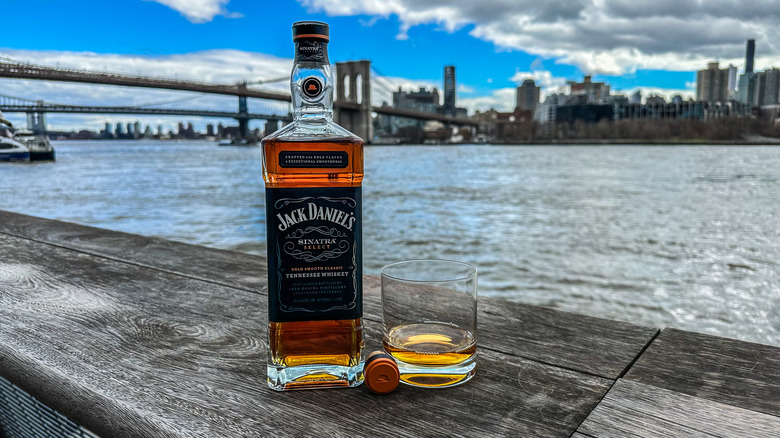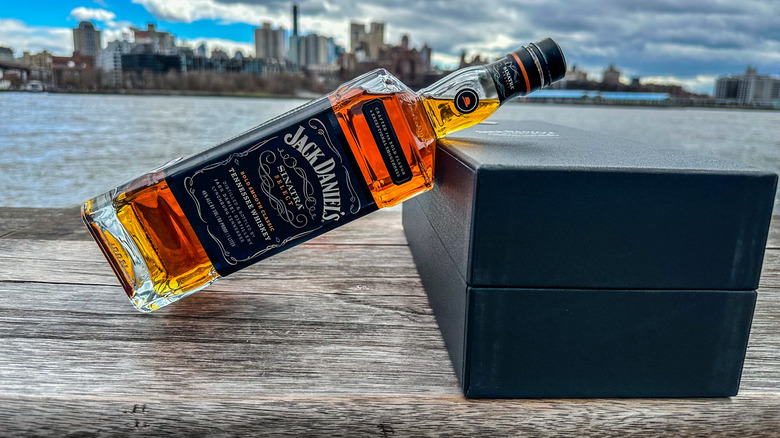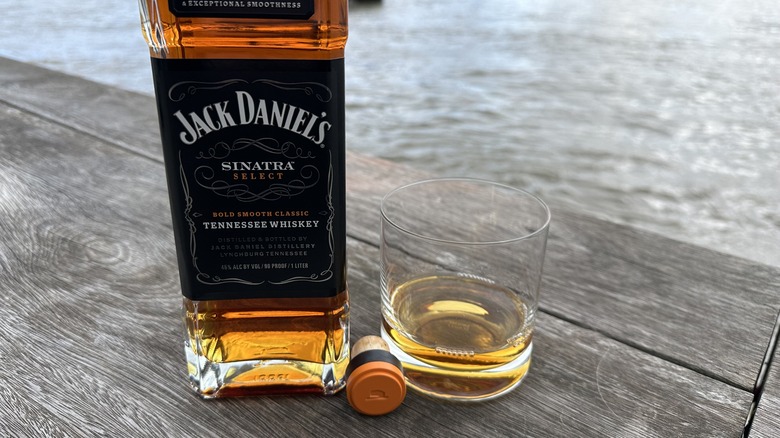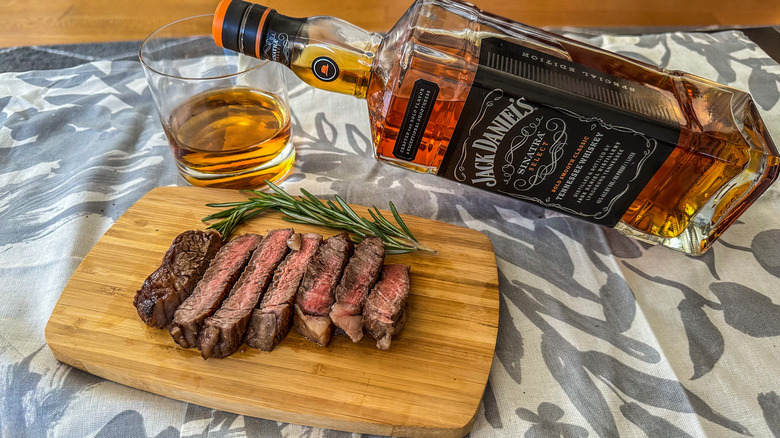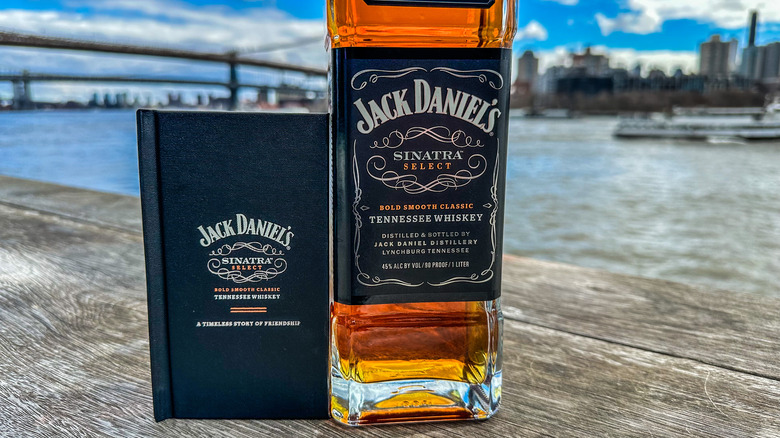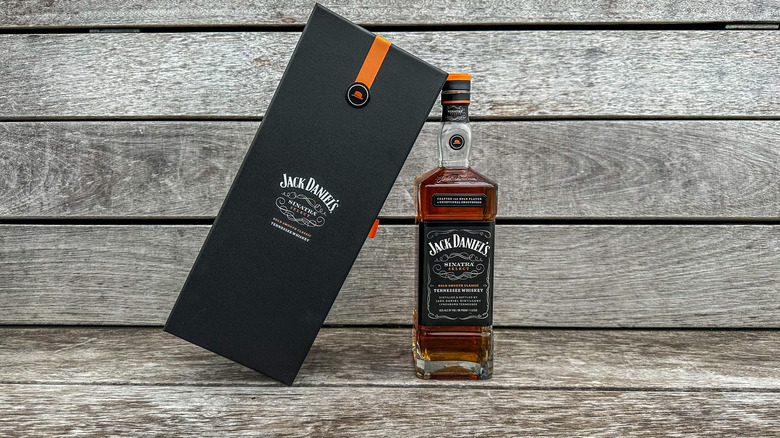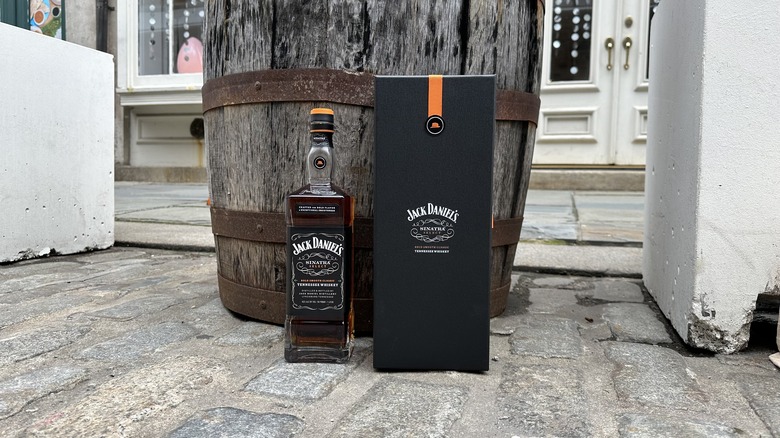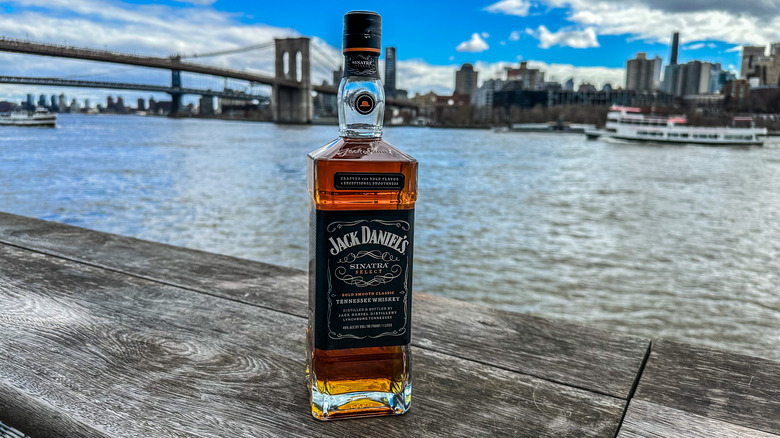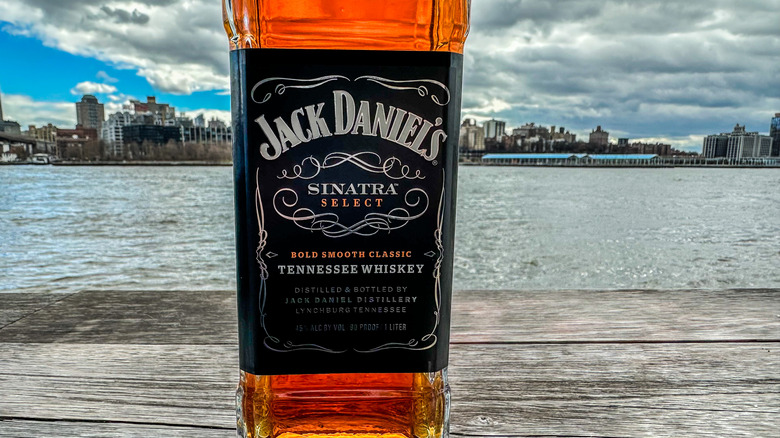Jack Daniel's Sinatra Select: The Ultimate Bottle Guide
In the world of American-made whiskey, few brands spark as much name recognition as Jack Daniel's. The brand has produced a variety of specialty spirits since its flagship whiskey, Old No. 7, came into the world in 1867, catering to a loyal, whiskey-loving fanbase. While these newer expressions have garnered attention far and wide, nothing has given off such an air of sophistication as Sinatra Select.
The history of the Jack Daniel's distillery goes back to the 1800s, but the inspiration behind Sinatra Select comes from Ol' Blue Eyes himself, Frank Sinatra. As someone who was somewhat of a self-proclaimed Jack Daniel's brand ambassador, Sinatra was often seen with a glass of Jack Daniel's and some would say it was his favorite whiskey of all time.
In this bottle guide, we will cover the artistry with which Sinatra Select was created, from the liquid itself to the bottle it comes in and even to the barrels it's aged. We'll explore the details that set Sinatra Select apart from its distillery predecessors and provide the information you need to decide if embarking on this spirited journey is right for you. While we were sent a bottle of Sinatra Select from the Jack Daniel's distillery, it in no way influenced our point of view on the spirit or any of the content in this bottle guide. That said, let's get educated on this expression from Jack Daniel's, a spirit deeply rooted in history, culture, and whiskey production in its purest form.
How is it made?
The production process for Sinatra Select isn't too different from that of its sibling, the original Jack Daniel's Old No. 7, which seems only fitting based on Sinatra's history with the spirit. According to Chris Fletcher, Master Distiller for Jack Daniel's, the process starts the same as No. 7 does, with a mash bill of 80% corn, 12% malted barley, and 8% rye. The Sinatra Select uses the same water and yeast and is distilled in the same copper stills as its predecessor.
At the heart of any good aged whiskey is the barrel in which it spends most of its time, where Sinatra Select sets itself apart. "The barrel is the number one ingredient in the whiskey," said Fletcher. "We were experimenting with how we could drive more of the barrel flavor into the whiskey."
After the toasting and charring process, the Sinatra Select barrels undergo an extra step. According to Fletcher, the barrels are sent to a routering station, where they are spiraled and grooved internally using a Dremel-like tool, about a quarter of an inch deep and a quarter of an inch wide. By carving out these internal spirals in the barrel, the surface area of the wood increases, driving more extraction of oak solids into the whiskey.
"This was one of the most successful applications of cooperage innovation," notes Fletcher. "It was a beautiful alignment of time that allowed us to utilize grooved barrels for this."
What does Jack Daniel's Sinatra Select taste like?
At its core, Sinatra Select is just what the Chairman of the Board insisted on sipping throughout his life: Old No. 7. And like his whiskey of choice, Sinatra Select does share a lot of the same tasting notes: On the nose, there's classic sweet fruit, brown sugar, vanilla, and oak. The palate is where things change, as the grooved barrels enhance the flavor of Sinatra Select into something with a little more heat and spice and a fuller mouthfeel, becoming more of a sipping whiskey than the Old No. 7.
The grooved barrels help make Sinatra Select's palate spicy and tannic, with the toasted char from the barrels coming through on the back end and providing a sweet, smooth finish. For Chris Fletcher, Sinatra Select is a bolder, more nuanced whiskey that adds more oak flavor and brings more barrel character into the liquid itself. Sinatra Select is a natural step up for those who like Old No. 7 but are looking for something a little more grown up, with a little more heat and flavor behind it.
How best to enjoy it
Sinatra Select has a lot of versatility, allowing it to be enjoyed in multiple ways depending on the kind of whiskey drinker one is. We recommend trying it neat before introducing additional ingredients or enhancers to get a feel for the spirit and better understand the liquid's simplest form. As a 90-proof spirit, Sinatra Select is not for the faint of heart; if the neat sip is too strong, an ice cube will more than help to mellow things out. Of course, you can always enjoy Sinatra Select the Sinatra way: in a heavy crystal rocks glass with three ice cubes, a two-finger pour, and a splash of water.
The notes of vanilla, baking spices, and dark fruit lend Sinatra Select to be just as enjoyable neat as it is in some of our favorite classic cocktails. We enjoy this most in a classic Manhattan, where the oaky, tannic notes can add intensity and complex flavor to a cocktail that relies heavily on a base spirit that can stand up on its own. "Any way you want to go, this is a classic whiskey profile," said Chris Fletcher. "Something Frank and Jack [Daniel's] would be proud of."
For red meat connoisseurs, Sinatra Select is also an impeccable choice for grilled beef or any dish that brings in some smoke, further bringing out the whiskey's toasted, oaky flavors. We also recommend enjoying it alongside a sweet and decadent dessert, like a dark chocolate raspberry cheesecake truffle.
Why is it so expensive?
For avid Scotch and whiskey drinkers, especially in the United States, it's no surprise when you're asked to pay premium prices for a high-quality spirit. And, while that price tag may not necessarily come as a surprise for a spirit from Scotland, Ireland, Japan, or the like, seeing a high price tag on a bottle from Jack Daniel's can come off as a bit of a shock. While it may seem like the Sinatra name sets this bottle at its whopping $174 price point, it's so much more than that. For the Jack Daniel's team and the Frank Sinatra Foundation, who had a heavy part in designing the bottle, Sinatra Select is an experience beyond the liquid.
A bottle of good whiskey is so much more than the whiskey itself; the sum of its parts adds to its allure and grandeur. The glass used for the Sinatra Select bottle, which is far heavier than a bottle of Old No. 7, is imported from Italy. The company typically imports the cork from Portugal and is of the highest grade it can source. The box that the bottle comes in is custom-made and has a book of facts about Frank Sinatra and his storied career. In the fashion of Jack Daniel's himself, Sinatra Select is a product that is tastefully produced from start to finish, and the price point reflects that premium experience.
Jack Daniel's Sinatra Select vs. Jack Daniel's No 7
Finding another American-made whiskey to compare to something from the Jack Daniel's portfolio isn't much of a daunting task; bourbons and American-made whiskies tend to have a lot of overlap when it comes to production and flavor profiles. However, it seemed only fitting to compare Sinatra Select to its core spirit, the spirit that Frank Sinatra himself was known for drinking exclusively and regularly referred to as "the Nectar of the Gods" and "the best booze in the world made in Lynchburg, Tennessee": Old No. 7.
From a flavor standpoint, Old No. 7 is a more balanced, mellow spirit than Sinatra Select. It is aged in new, handcrafted American white oak barrels and bottled at 80 proof for a more easy-going sip, whereas Sinatra Select has a more complex, tannic flavor focusing on the charred oak from the toasted and grooved barrels. Pricewise, Old No. 7 is far more affordable, at a reasonable $35 for the 750 mL bottle, whereas Sinatra Select is in the premium category for around $174. Upgrading to Sinatra Select is a wise choice for the whiskey drinker who enjoys Old No. 7 but wants something more elevated. Otherwise, do as the Chairman of the Board himself did, and so many rock and roll stars continue to do and enjoy the original Jack Daniel's expression at a more appealing price point.
Each Sinatra Select Barrel has internal grooves to drive the oaky flavor
The Jack Daniel's Brown-Forman Cooperage in Louisville, Kentucky, is doing a lot of the heavy lifting when it comes to Sinatra Select, as the difference between this expression and the rest of the Jack Daniel's portfolio is in the barrel itself. The barrel grooves and the wood shavings are what set Sinatra Select apart as one of the more unique offerings not just from Jack Daniel's, but from any American whiskey distillery.
As a young chemist starting at the Jack Daniel's distillery, Chris Fletcher poured over the importance of the grooved barrels and how each process element added to the final product. The team would count and measure each groove, ensuring that the same amount of wood was shaved off and that the weight of the shavings from those internal grooves was consistent with each barrel. According to Tennessee whiskey requirements, the shavings had to stay in the barrel because it is part of the toasting and charring process of those new charred oak barrels, providing more extraction once the clear spirit is poured into the barrels and sent to Lynchburg for aging. After four to five years in the barrel, the spirit is ready to be bottled and enjoyed, taking with it the grooved barrel's uniquely tannic and oak-forward flavors.
Frank Sinatra was never a paid Jack Daniel's brand ambassador
According to Jack Daniel's resident historian, Nelson Eddy, music is an integral part of the Jack Daniel's name, returning to Mr. Jasper Newton "Jack" Daniel, who understood music's power on people. To connect to the masses, he worked to tie his spirit brand to this cultural touchpoint in various ways, starting with the Jack Daniel's Silver Cornet Band in 1892 and continuing with Frank Sinatra.
Frank Sinatra was first introduced to the Tennessee-born spirit by his friend and Rat Pack originator, Humphrey Bogart. As a spirit that was hard to get ahold of in the 1950s and '60s, when the distillery was much smaller, having Sinatra advocate for it was a significant boon to the brand itself. And, to the credit of the distillery and Sinatra himself, he was never paid to drink or talk about it. After being introduced to Old No. 7, he decided that this would be his tipple of choice, almost always walking out on stage with a glass of Jack Daniel's in hand.
With Frank's proverbial blessing, Jack Daniel's has continued to be an essential part of American pop culture. According to Chris Fletcher, Sinatra was buried with a mini bottle of Jack Daniel's on the lapel of his jacket. From his first sip until his last breath, Sinatra was dedicated to a brand he genuinely admired without receiving a single cent to croon its praises.
Jack Daniel's still uses the same mother yeast from Prohibition
If the grooved barrels are the most important aspect of the Sinatra Select process, the yeast used in the whiskey is the second most important. According to Chris Fletcher, when his grandfather started at the Jack Daniel's distillery as Master Distiller in the 1950s, the "mother yeast" used in the mash was kept in an old copper jug and kept in a creek in the back of the distillery for refrigeration. Today, as technology has improved and a general sense of efficiency has taken over, that mother yeast is still in existence but treated with much more care. The company now works with a microbiologist who, with the help of his team in the lab at the Jack Daniel's distillery, cleans and tests the yeast regularly, identifying the different strains in the yeast to find out where that primary Jack Daniel's flavor comes from. This ensures that it can be used week in and week out for continued whiskey production.
As the decades have progressed and the team has upgraded from that old copper jug, the mother yeast has been upgraded, too. While it is regularly kept cryogenically frozen between -40 and -50 degrees Fahrenheit, it is warmed up and regenerated every few years to wake it up and continue to culture and purify it. This results in a yeast that can be used repeatedly to produce a consistent, quality product.
